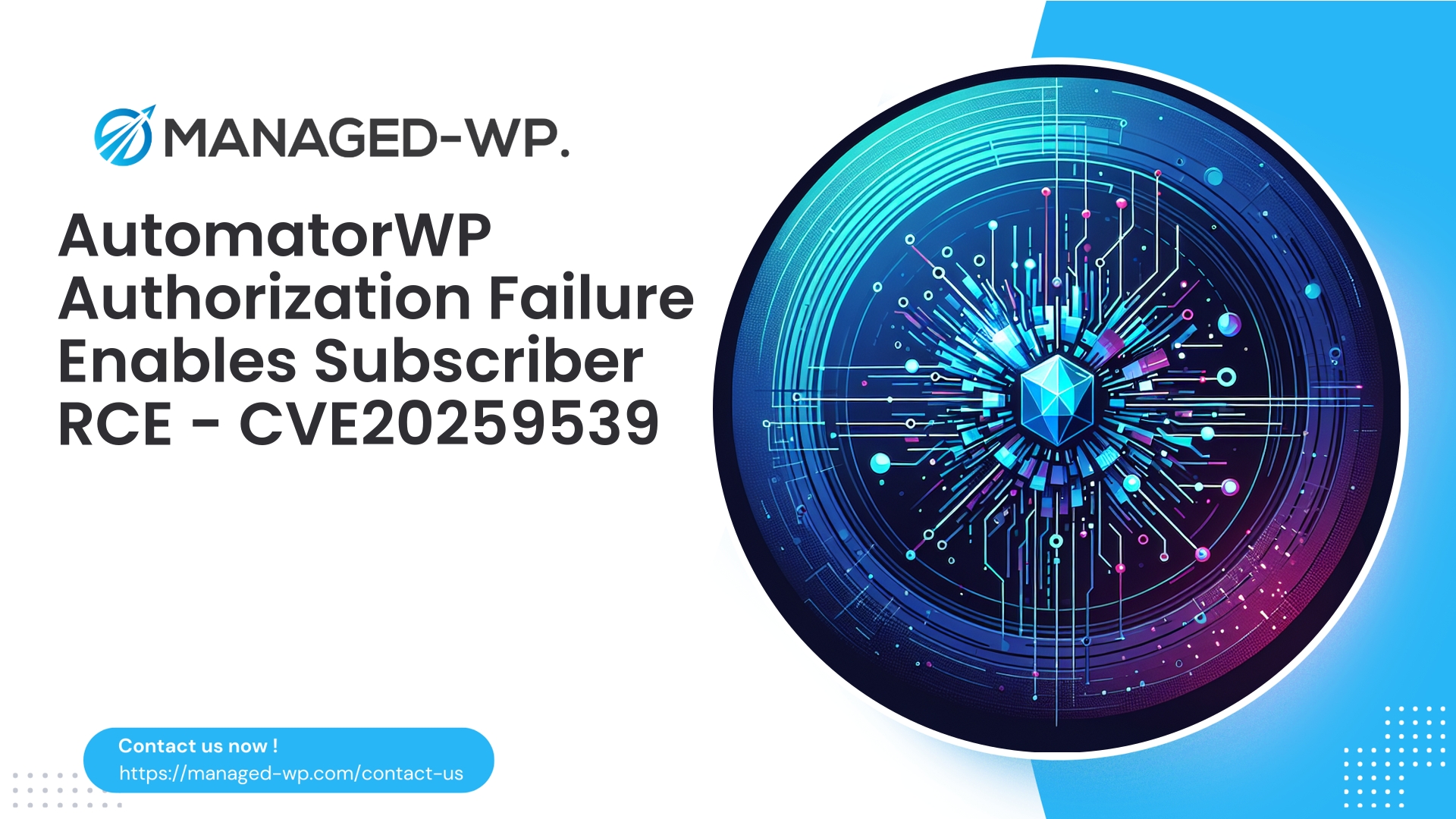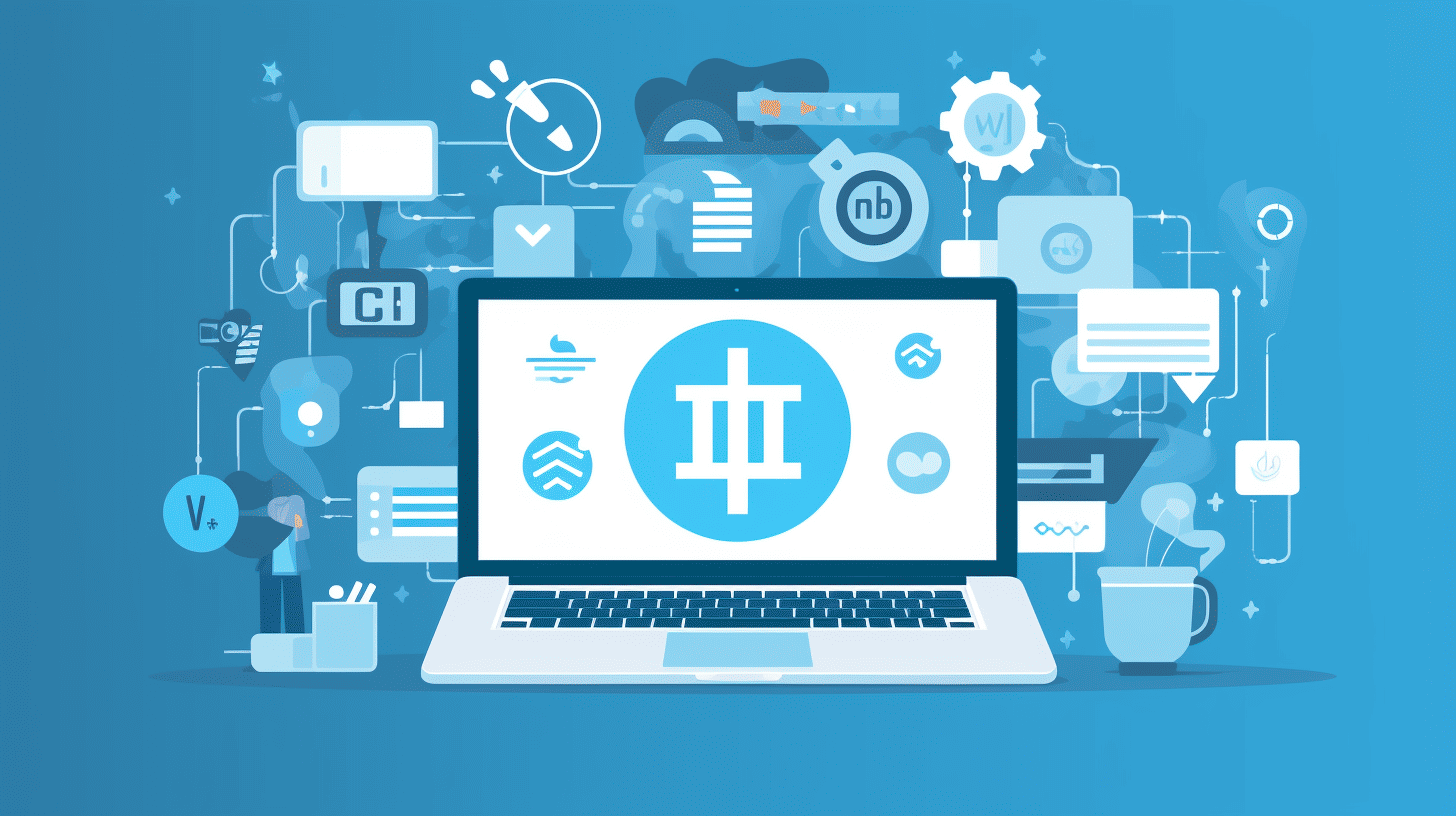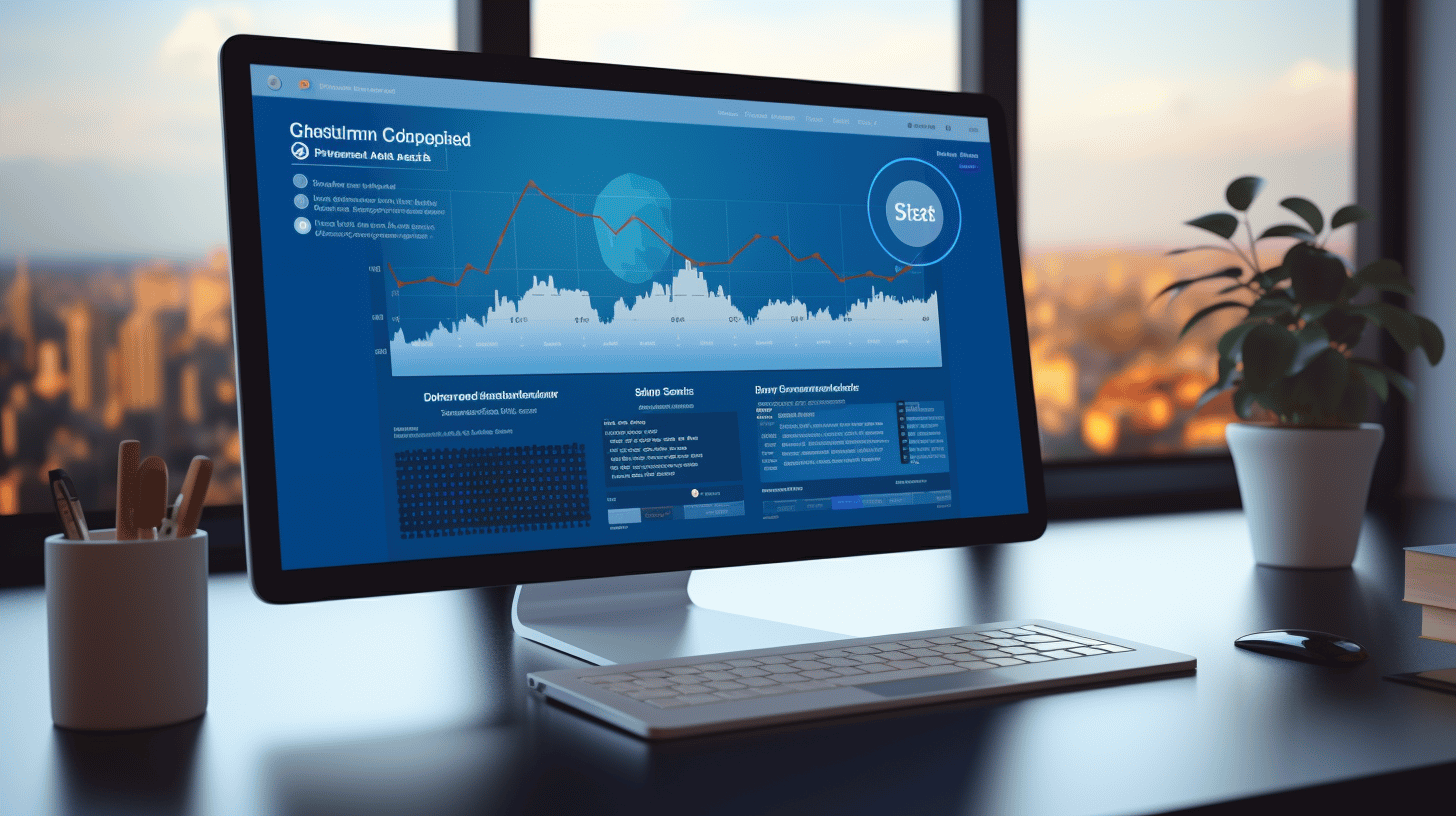| Plugin Name | AutomatorWP |
|---|---|
| Type of Vulnerability | Remote Code Execution (RCE) |
| CVE Number | CVE-2025-9539 |
| Urgency | High |
| CVE Publish Date | 2025-09-08 |
| Source URL | CVE-2025-9539 |
Critical Alert: AutomatorWP ≤ 5.3.6 — Missing Subscriber-Level Authorization Enables Remote Code Execution (CVE-2025-9539)
Comprehensive analysis, risk evaluation, detection strategies, and a detailed remediation guide for the AutomatorWP plugin vulnerability (versions ≤ 5.3.6). Includes virtual patching options through Web Application Firewall (WAF) and essential hardening recommendations from the Managed-WP security experts.
Author: Managed-WP Security Team
Published: 2025-09-08
Tags: WordPress, Security Vulnerability, AutomatorWP, Remote Code Execution, WAF, Cybersecurity
Executive Summary
A critical security flaw has been identified in the AutomatorWP WordPress plugin (CVE-2025-9539). Versions up to and including 5.3.6 are affected by a missing authorization check vulnerability. This flaw allows authenticated users with as little privilege as the Subscriber role to craft and trigger malicious automations that enable remote code execution (RCE) on the hosting server.
This vulnerability represents a considerable threat because:
- Subscribers are a baseline role assigned to many legitimate users, including customers, commenters, and members.
- The construction of automations allows for complex sequences that may elevate user-controlled inputs into executable code on the server, enabling attackers to compromise the infrastructure.
Managed-WP strongly advises immediate patching to AutomatorWP 5.3.7. If an immediate update is not possible, follow the mitigation measures outlined below, including firewall-based virtual patching, strict access controls, and enhanced monitoring.
This briefing reflects the experienced perspective of Managed-WP’s security team, focusing on actionable defense mechanisms, detection methodologies, and comprehensive incident response.
Key Facts
- Vulnerability Type: Missing authorization for authenticated Subscriber or higher → Remote Code Execution
- Impacted Versions: AutomatorWP ≤ 5.3.6
- Issue Resolved In: Version 5.3.7
- CVE Identifier: CVE-2025-9539
- CVSS Score: 8.0 (High severity)
- Minimum Privilege Level Required: Subscriber (authenticated)
- Reported by: Public security researcher
- Exploitation Feasibility: Low privileged accounts can weaponize automations, no admin rights required
Why This Vulnerability Demands Immediate Attention
WordPress installations frequently enable user registration workflows or host membership and e-commerce portals, where accounts with Subscriber-level privileges are abundant. Attackers exploiting this vulnerability can:
- Create malicious automations that execute server-side code or manipulate plugin mechanics to run arbitrary commands.
- Trigger these automations on-demand or according to scheduled events to achieve remote code execution.
- Deploy backdoors, move laterally to other hosted sites, or inject malicious content into web assets.
The low privilege threshold increases the risk of large-scale automated compromise attempts. Administrators should assume attackers will actively scan for and exploit this vulnerability post-disclosure.
Attack Sequence Overview (Non-Exploitative Description)
- Attacker registers or uses an existing WordPress account with Subscriber privileges.
- Using plugin automation creation interfaces (web UI, AJAX, or REST APIs), attacker submits crafted automations with payloads that lead to code execution.
- Due to missing authorization checks, the plugin accepts and stores these dangerous automation configurations.
- Attacker triggers the automation, leading to arbitrary command execution on the server.
- Post-exploitation activities may include privilege escalation, persistence, and data exfiltration.
Note: For security and ethical reasons, no exploit code or payload details are provided here.
Detection and Indicators of Compromise (IoCs)
If your WordPress environment runs AutomatorWP ≤5.3.6, actively monitor for these signs before and after compromise:
Immediate Detection Checks:
- Unfamiliar or recently modified AutomatorWP automations—validate creator and legitimacy.
- Unexpected scheduled tasks or cron events associated with AutomatorWP automations.
- Unusual admin-ajax.php or REST API POST requests from Subscriber or similarly low-privileged accounts creating automations.
- New or modified PHP files within writable plugin or theme directories, especially obfuscated source code.
- File content containing suspicious patterns such as
eval,base64_decode,system, orexec. - Suspicious serialized data or database entries referencing executable payloads in plugin options or automation meta-data.
- Outbound network connections from your server to unknown destinations.
- Unexpected logins, new user registrations, or privilege escalations involving Subscriber accounts.
Recommended Log Auditing:
- Web server logs scanning for POST requests to AutomatorWP endpoints from non-admin users.
- Examination of WordPress debug logs for anomalies or plugin errors.
- Database searches within
wp_postsandwp_postmetatables for suspicious automations. - Host-level process and log reviews to identify unauthorized code execution.
Useful Search Queries:
- Look for dangerous function usage strings (
eval(,base64_decode(,create_function(). - List files modified within the last two weeks:
find . -type f -mtime -14 -ls
Immediate Mitigation Steps
- Patch AutomatorWP immediately to version 5.3.7 or higher — the definitive fix.
- If patching now is not feasible:
- Deactivate the AutomatorWP plugin temporarily via WP-Admin or WP-CLI (
wp plugin deactivate automatorwp).
- Deactivate the AutomatorWP plugin temporarily via WP-Admin or WP-CLI (
- Employ firewall rules to restrict automation creation endpoints:
- Block unauthenticated or Subscriber-role requests attempting automation creation.
- Implement traffic rate-limiting on automation-related endpoints.
- Strengthen user management:
- Enforce manual user approvals and remove suspicious Subscriber accounts.
- Initiate password resets where compromise is suspected.
- Temporarily suspend user registration if not necessary.
- Review assigned capabilities:
- Ensure only authorized roles have permissions related to automation creation.
- Remove or quarantine any suspicious automations:
- Increase continuous monitoring for new admin users, file changes, and unusual network traffic.
Managed-WP customers benefit from ready-to-deploy WAF virtual patching rules that restrict exploit attempts while awaiting updates.
Virtual Patching with Web Application Firewall (WAF)
Web Application Firewalls serve as an effective interim layer of defense by blocking suspicious exploit attempts until patching is complete. Managed-WP recommends virtual patching strategies that:
- Block automation creation POST requests originating from Subscriber roles or unauthorized sources.
- Identify and reject payloads containing suspected execution patterns.
- Apply rate-limiting to prevent mass automation submissions from single IPs.
Important: Virtual patching mitigates risk but does not replace the urgent need to update the plugin to a fixed version.
Example WAF Rule Patterns (Conceptual Templates):
# Block automation creation POSTs from low-privileged users (concept) SecRule REQUEST_METHOD "POST" "chain,deny,msg:'Block AutomatorWP automation creation from Subscriber users'" SecRule REQUEST_URI "@beginsWith /wp-admin/admin-ajax.php" "chain" SecRule ARGS_NAMES|ARGS "*automation*" "chain" SecRule REQUEST_HEADERS:Cookie "@contains wordpress_logged_in_" "t:none"
Notes:
- Your WAF needs to correlate authenticated sessions with WordPress user roles or rely on heuristics such as IP reputation and request parameters.
- Test rules carefully to avoid blocking legitimate administrative activities.
Managed-WP managed WAF customers can leverage these protections seamlessly across their environment to reduce risk immediately.
Systematic Remediation Checklist
- Patch the AutomatorWP plugin to 5.3.7+ using WP dashboard or WP-CLI (
wp plugin update automatorwp). - Verify plugin functionality and validate that legitimate automations operate correctly.
- Audit all existing automations, disable or delete those not explicitly approved.
- Reset credentials for administrative and subscriber accounts if suspicious activity is detected.
- Scan for webshells, unexpected PHP files, or unusual scheduled tasks.
- Review logs for anomalies related to AutomatorWP usage.
- Revoke any compromised API keys or tokens associated with AutomatorWP automations.
- Temporarily disable open user registration if feasible.
- Enforce security best practices such as two-factor authentication and strong password policies.
- If RCE presence is confirmed, engage professional incident responders for forensic analysis.
Long-Term Security Best Practices
- Principle of Least Privilege:
- Limit capabilities granted to user roles to only those necessary for their functions.
- Plugin Vetting and Management:
- Choose plugins with robust development, auditing, and security track records.
- Automated Updates:
- Enable auto-updates for critical plugin security patches where appropriate.
- Active WAF Deployment & Virtual Patching:
- Leverage WAF controls for rapid mitigation against emerging threats.
- Centralized Monitoring & Alerting:
- Implement logs aggregation and real-time alerting on suspicious plugin and system behavior.
- Regular Malware Scanning & Backups:
- Maintain routine malware scans and offsite backups with verified restore processes.
- Incident Response Planning:
- Develop and regularly update plans to swiftly contain and remediate compromised sites.
- Network Segmentation:
- Isolate web servers as much as possible to limit attacker lateral movement.
Safe Inspection of AutomatorWP Automations
- If available, export automations and analyze them offline in a controlled staging environment.
- When in-place inspection is required, carefully examine all action fields for signs of code execution or encoded payloads.
- Disable suspicious automations promptly and validate others in a test environment.
Concise Incident Response Playbook
- Detection: Identify unexpected automations, cron jobs, or files.
- Containment: Deactivate the AutomatorWP plugin and isolate affected servers.
- Eradication: Remove backdoors, malicious files, and rebuild compromised components.
- Recovery: Restore from known-good backups and update all affected software.
- Lessons Learned: Analyze root causes and update defenses accordingly.
If you confirm active remote code execution, engage specialized incident response professionals immediately for detailed forensic investigations.
Sample WAF Rule Templates (Neutral and Adaptable)
Below are neutral, easy-to-adapt example rules for your WAF. Always test in a staging environment before deployment:
1) IP-Restricted Automation Creation Blocking
# Block automation creation unless request originates from trusted IP range SecRule REQUEST_METHOD "POST" "chain,phase:1,deny,status:403,msg:'Block AutomatorWP automation creation - untrusted IP'" SecRule REQUEST_URI "@rx /wp-admin/admin-ajax.php" "chain" SecRule ARGS_NAMES|ARGS "automation|create_automation" "chain" SecRule REMOTE_ADDR "!@ipMatch 203.0.113.0/24 198.51.100.17"
2) Rate-Limit Automation Creation Attempts
# Rate limiting automation creation POST requests
SecAction "phase:1,pass,nolog,initcol:ip=%{REMOTE_ADDR},setvar:ip.automator_count=+0"
SecRule REQUEST_METHOD "POST" "phase:2,chain,pass,id:10001"
SecRule REQUEST_URI "@rx /(admin-ajax\.php|wp-json/automatorwp)" "chain"
SecRule IP:AUTOMATOR_COUNT "@gt 3" "phase:2,deny,status:429,msg:'Excessive AutomatorWP automation creation requests'"
SecAction "phase:2,pass,setvar:ip.automator_count=+1"
3) Block Suspicious Execution Payload Patterns
# Block POST request bodies containing typical server execution functions SecRule REQUEST_BODY "@rx (eval\(|base64_decode\(|system\(|exec\(|passthru\()" "phase:2,deny,status:403,msg:'Suspicious server execution pattern detected'"
Adapt these templates carefully to your environment and thoroughly validate to prevent false positives.
30-Day Audit & Monitoring Timeline
- Day 0: Patch AutomatorWP or deactivate plugin.
- Day 0–2: Scan filesystem for new PHP files and review access logs.
- Day 0–7: Audit automations and scheduled tasks.
- Day 3–14: Deploy WAF virtual patches and start monitoring blocked requests.
- Day 7–30: Review user accounts, force password resets for at-risk users, monitor unusual outbound connections.
Why This Takes Priority Over Routine Updates
This vulnerability demands urgent attention because:
- The privilege level needed to exploit is minimal.
- The attack leads to a full remote code execution scenario, posing severe risk.
- Automated exploitation attempts frequently begin immediately following public disclosure.
Delaying corrective actions significantly increases the window of vulnerability and potential impact. Treat this as a critical security emergency.
Multi-Site and Managed Environment Considerations
- Prioritize patches on sites with enabled user registration, e-commerce or membership functionalities.
- Implement centralized update orchestration and verify updates within staging environments before wide rollout.
- Use network-level virtual patching if feasible to protect multiple sites simultaneously.
Communications Guidance for Stakeholders
Non-technical summary:
“A high-severity vulnerability affecting the AutomatorWP plugin could allow users with basic access levels to run potentially harmful commands on our servers. We have applied patches and additional safeguards to protect all systems and are actively monitoring for any impact.”
Technical briefing: Share detailed timelines, remediation status, and confirmation once investigations indicate closure.
Frequently Asked Questions
Q: Can unauthenticated visitors exploit this vulnerability?
A: No, the attack requires an authenticated user account with Subscriber role permissions or higher.
Q: Does restoring from a backup resolve the issue?
A: Restoring to a clean pre-compromise backup helps, but ensure the patch is applied before bringing the site back online to prevent reinfection.
Q: Is temporarily disabling AutomatorWP sufficient?
A: Disabling removes the immediate risk surface, but a thorough investigation and cleanup are required if compromise is suspected.
Immediate Protection with Managed-WP Basic Plan (Free)
To mitigate risk quickly, Managed-WP offers a Basic (Free) managed firewall service providing essential protections, including a powerful WAF, malware scanning, and defenses aligned with OWASP Top 10 threats. You can enable virtual patching rules immediately to reduce exposure while applying plugin updates. Learn more and enroll here: https://my.wp-firewall.com/buy/wp-firewall-free-plan/
For enterprise and advanced features including proactive virtual patching, consider our Standard or Pro plans.
Closing Remarks from Managed-WP Security Experts
This AutomatorWP incident highlights a fundamental principle in WordPress security: plugins that empower users to build automations must enforce strict authorization checks. Despite a straightforward fix, multiple layers of defense are paramount — including least privilege enforcement, virtual patching via WAF, continuous monitoring, and a well-practiced incident response plan.
Managed-WP stands ready to assist customers in vulnerability assessment, virtual patch deployment, and incident handling. Remember, security is an ongoing effort—swift action today significantly reduces tomorrow’s risk.
Stay vigilant, patch promptly, and monitor continuously.
— Managed-WP Security Team



















